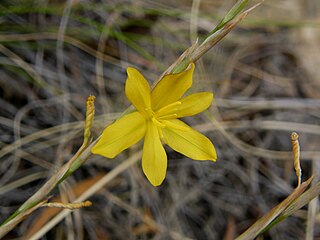
Dietes is a genus of rhizomatous plants of the family Iridaceae, first described as a genus in 1866. Common names include wood iris, fortnight lily, African iris, Japanese iris and butterfly iris, each of which may be used differently in different regions for one or more of the six species within the genus.

Robert Sweet was an English botanist, horticulturist and ornithologist.

Moraea, the Cape tulips, is a genus of plants in the family Iridaceae, first described as a genus in 1758. The group is widespread across Africa, the Mediterranean, and central and southwestern Asia. The genus name is a tribute to the English botanist Robert More.

Utricularia ochroleuca, the yellowishwhite bladderwort, pale bladderwort, or cream-flowered bladderwort, is a small, perennial carnivorous plant that belongs to the genus Utricularia. It is usually found affixed to the substrate. U. ochroleuca is a circumboreal species and is found in North America, Asia, and Europe.

Moraea bituminosa is a species of the genus Moraea in family Iridaceae.

Spiranthes ochroleuca, commonly called the yellow nodding lady's tresses, is a species of orchid occurring from southeastern Canada to the eastern United States.
Moraea vuvuzela is a plant named after the noisy trumpet, vuvuzela. Moraea is a genus of plants in the family Iridaceae.

Moraea collina is a species of the genus Moraea, in the family Iridaceae. It was formerly known as Homeria collina.

Scabiosa ochroleuca, commonly called cream pincushions or cream scabious, is a species of scabious with creamy yellow flower heads. It is native to Europe and western Asia.

Moraea aristata is a species of flowering plant in the family Iridaceae. It is referred to by the common names blue-eyed uintjie or Blouooguintjie in Afrikaans and is a critically endangered species of plant in the genus Moraea, that is endemic to the city of Cape Town and is now restricted to the grounds of the Observatory in the Cape Town suburb of Observatory.

Swartland Shale Renosterveld is a critically endangered vegetation type of the Western Cape, South Africa.

Diplarrena moraea, commonly known as white iris, is a member of the iris family, Iridaceae. It occurs in Australian heathland and forest in New South Wales, Victoria and Tasmania.

Moraea gawleri is a species of plant in the family Iridaceae. It is found in North Cape, South Africa.

Moraea gigandra is a species of plant in the family Iridaceae. It is found in South Africa.

Moraea fugacissima is a plant species in the family Iridaceae.

Moraea virgata is a plant species in the family Iridaceae.

Moraea sisyrinchium, the Barbary nut, is a species of flowering plant, a dwarf iris, in the genus Moraea, native to southern Europe and the Mediterranean region.

Argemone ochroleuca is a species of prickly poppy, a flowering plant commonly known as pale Mexican prickly poppy or Mexican poppy. It is native to Mexico and is also an introduced weed in many temperate and tropical regions of the world. It can grow up to 1 m in height and has a sticky yellow sap.

Moraea filicaulis is a flowering plant in the iris family, Iridaceae. It is endemic to South Africa where it occurs in Namaqualand, Knersvlakte, Olifants River Valley, and the West Coast. Moraea filicaulis is considered a species of least concern as it is widespread and common. It has previously been considered a subspecies of Moraea fugax.


















